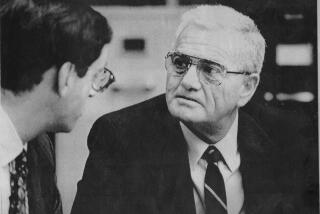THE O.J. SIMPSON MURDER TRIAL
- Share via
UCLA law professor Peter Arenella and Loyola University law professor Laurie Levenson offer their take on the Simpson trial. Joining them is Southwestern University law professor Myrna Raeder, who will rotate with other experts as the trial moves forward. Today’s topic: The DNA war drones on and on.
PETER ARENELLA
On the prosecution: “Rockne Harmon’s redirect was somewhat easier to follow than Barry Scheck’s cross-examination. Harmon attacked the cross-contamination theory by showing that none of the substrate controls had evidence of contamination. He responded to defense suggestions that the bloodstain at the Bundy rear gate must have been planted because it was not degraded by showing through conventional serology tests that there was some degradation.”
On the defense: “Sometimes too much knowledge is a dangerous thing. Scheck’s considerable expertise allowed him to pursue technical lines of inquiry that few in the courtroom could follow. Obscured by the scientific miasma were two essential points: Blood on the rear gate showed far less degradation than the Bundy blood drops, even though it was collected weeks later, and Sims’ analysis of some test results required debatable interpretations of ‘imperceptible’ differences.”
LAURIE LEVENSON
On the prosecution: “Harmon out-hypotheticaled Scheck. Harmon had Sims show how unlikely it is that O.J.’s blood from Rockingham contaminated all the samples at Bundy. Harmon then planted in the jurors’ brains a key question: ‘Where is Dr. Blake?’ Given that Blake was present for DNA testing and the defense had access to the evidence for their own testing, if Blake does not testify, jurors are likely to surmise that defense tests produced similar results.”
On the defense: “Fastening, scintillating, informative, devastating, clear, concise, dynamite--none of these words applied to Scheck’s cross-examination of DNA expert Sims. Scheck may have enjoyed his scientific chat with Sims, but the jurors probably felt like they were watching a foreign-language film with no subtitles. Scheck wanted to show the jurors that DNA results are subject to interpretation but his message may have gotten lost in the delivery.”
MYRNA RAEDER
On the prosecution: “Scheck had difficulty with both Judge Ito and Sims when he kept offering hypotheticals that neither agreed with. Sims more than survived Scheck’s examination, coming across as a highly believable follow-up to Robin Cotton and rounding out the prosecution’s one-two DNA punch. Harmon honed in on Sims’ opinion that it was not conceivable for contamination to hopscotch over the substrate controls and infect the all important Bundy blood drops.”
On the defense: “Scheck demonstrated that he could score points even with an excellent witness. He used Sims to set up contamination at the LAPD lab and revisit the conspiracy theory: Jurors will want explanations about why there was more blood on the socks and the rear gate than on other samples. Scheck also focused on proficiency testing and the blood mixture in the Bronco, but much of the questioning was highly technical and perhaps unintelligible to jurors.”
Compiled by HENRY WEINSTEIN / Los Angeles Times
More to Read
Sign up for Essential California
The most important California stories and recommendations in your inbox every morning.
You may occasionally receive promotional content from the Los Angeles Times.













